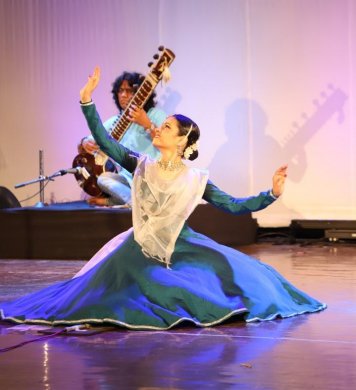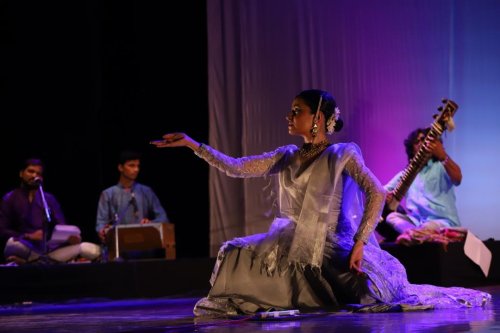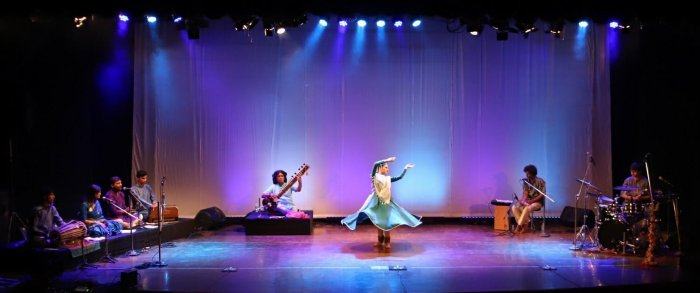
|   |

|   |
 e-mail: sunilkothari1933@gmail.com An unusual Kathak performance by Ishwari Deshpande Photos: Rashmi Navelkar July 10, 2019 In August 2013, when Guru Mohan Rao Kallianpurkar's centenary celebrations were held at Pune by Prerana Deshpande's Nrityadham and Shama Bhate's Naad Roop Kathak institutions, Prerana Deshpande had performed in Chitramala composed by Mohan Rao. In Ganga Jamuna section, Ishwari Deshpande, 16, (daughter of Prerana and tabla vadak Supreet Deshpande) in the centre had executed the taal with such confidence and brilliance that the celebrated musician Satyasheel Deshpande had spontaneously said: "Wah, she is like AK47 Rifle!" That sweet 16, now 22, has turned into a mature Kathak exponent. Her recital on 29th June at Shakuntala Jagannath Auditorium, under the aegis of Nrityadham, was proof of her maturity and growth as brilliant dancer. Everything is going good for petite, charming Ishwari. From the age of three, she has been brought up in an atmosphere where round the clock there was dance and music. Her mother Prerana, a disciple of late legendary pioneer in Kathak in Pune, Rohini Bhate, groomed her from very childhood. Father Supreet Deshpande, an ace tabla vadak, son of the celebrated Kiran Deshpande, provided all facilities for her training. Being a daughter of parents who are artistes of a very high standard, Kathak is in the genes of Ishwari. Her own deep interest has helped her bloom into a fine dancer.  What was special about this particular program titled Shanyayan, in praise of Lord Shani, the planet Saturn, was the excellent team work of young artistes. The accompanists were all young and keen to perform for such an unusual program where Prerana Deshpande has created a taal of 2 and half, 2 and half culmination into 7 and half. Not 5 and 2 and half. Not that easy way, but difficult with three khands of 2 and half each and one has to come to sam precisely in a manner which would seem so easy, but is in fact quite tough. During a conversation, Prerana told me that she wanted to explore the 7 and half matra taal for a long time. Inspired by the mythological story of Lord Shani, she composed a bandish in praise of Shani in taal she named Shanyayan. "Hey Shani taar lo" (O lord protect me). The story goes as follows, said Prerana: "I have called this taal time cycle as Shanyayan and bells. My first gurus are time and space. Our surroundings, the seasons and the planets have direct or indirect effect on our lives and our perspectives. In astrology, the god Shani, is said to be a tough influence on our lives, especially during a period of seven and half years (we call Shani ki saade saati), through three phases of 2 .5 years each. Most believers have a sense of fear or anxiety when the name of Shani is taken. On reading more about Shani, I realized that Shani is not troublesome, but more like the strict teacher who tests you to improve your ways. He is considered to be the god of justice, who puts you through a tumultuous time in your life to see whether you stay your ground by staying honest and principled, or you give in and take an easier way out." "Inspired by this and my own experiences, I wished to give my offerings to Shani Dev in the only way I can - my dance and my art. Thus the taal Shanyayan was created. It is unique because unlike all other half-matra taalas, Shanyayan does not have the half matras added just once. Shani Dev expects one to accept a difficult situation as it is and find a way with honesty and integrity, and not try to simplify it. Hence I have composed this taal with the intention of taking the difficulty head on - in its khand are 2.5, 2.5, 2.5, but such is not the way of Shani. In this taal, even the simplest composition becomes difficult because of the theka, and I have composed compositions that are even difficult in themselves!" "Not just the taal, even the movements choreographed in this are an attempt to invoke Shani by representing the various rings around the planet Saturn, or the phases of saade saati. The creation of this taal was a very natural process wherein the design or theka of the taal was spontaneous creation through feel, and the rest of the composition and choreography fell into place just as naturally. I gave a lot of thought to give name of this taal. Shani + ayan = Shanyayan (ayan meaning path). This creation is my path or way of surrendering to Shani Dev, hence Shanyayan. Even the composition, the bandish I gave to nagma is also my offerings to Shani: 'Ye jivan vikat bant par karan kathin' - this life is difficult to cross, it is not easy. One with pure mind and sincere meditation worships, he will have no difficulty in crossing the life. And I repeat, Hey Shani taar lo ye jivan." Prerana's explanation was almost like a choreographer's note and an entry point for audience to relish the performance.  Before the performance began, Mrunal, the charming young announcer, also a disciple of Prerana, introduced the accompanists. On pakhavaj was Krushna Salunke, disciple of Pandit Suresh Talwalkar, Umesh Warbhuvan on Western percussion drum, also a disciple of Suresh Talwalkar and of Tafiq Qureshi, Shravan Samsi, son / disciple of Yogesh Samsi currently studying under Sitara Devi's son Ranjit Barot, Aditya Apte on vocal, disciple of his father Madhusudan Apte, on harmonium was Abhishek Shinker, disciple of Pandit Pramod Marathe and Pandit Nath Neralkar, and on sitar was Pandit Ravi Chary, disciple of Shaheed Parvez. It was a galaxy of young generation of musicians under the leadership of Prerana Deshpande who conducted the recital. Ishwari began with the prayer of Shani and highlighted his epithets in movements, Shani as younger brother of Yama, with skin of bluish colour, dark, with large eyes, fierce in appearance, to that Lord Shani, I bow and offer my pranams. Ishwari, petite as she is, unleashed such energetic chakkars and postures evoking the image of Shani with aplomb. With beautiful aalap on sitar, Ravi Chary built up the mood. The bols, padhant, the reproduction on pakhavaj, on drum (from Tunisia, cajon pronounced as kahn), and western drums charged the atmosphere. The young musicians were in their element. Ishwari unfolded one after another the gems of nritta beginning with paran aamad of Mohanrao's 'dha taka dhunga' and executed with finesse and confidence arriving on the sam of the unusual Shani Taal. Sitting next to me were the veteran exponents of Kathak, Shame Bate and Bharatanatyam diva Sucheta Chapekar. They burst out with their spontaneous 'wah! wah!' For someone not tuned to this taal and arriving on the sam, it would be like tight rope walking, but for Ishwari it was a breeze. Paramparik nritta pieces, tihais, tisra jaati paran, performing with lightning speed, sitting on the floor and quickly getting up striking the final pose, Ishwari went on receiving rounds of applause, as the rasikas, well versed in intricacies of taal, appreciated her art. In between, the six accompanists like a jam session created an exciting mood. Each one played individually, displaying their artistry. And all of them together created a climax with resounding drums taking the lead. Ishwari performed to Utad Zakir Hussain's tihais bedam, kamali and explained where 'dha' will be played from first palle to the rest. Farmaishi bandhish were at her beck and call. The command over the form, laya and taal, were in full display. After sumptuous offering of nritta, Ishwari had a quick costume change with a transparent well designed off white tasteful drape on the dress and performed thumri, "Dekho mai tero Kanhai, mag rokat thithori karat" (Look Yashoda, your son Kanhai, blocks my way when I go to fetch water and teases me) in Bhairavi raga to the accompaniment of pakhavaj, as tabla was not included in this musical ensemble. It gave a different texture to display of thumri as one is traditionally used to listening to and watching thumri danced to tabla. Hoewever as an experiment it looked quite interesting.  The abhinaya part in Kathak needs emphasis and more presentation as nritta always takes a lead. Ishwari is well versed in abhinaya under the watchful guidance of her mother. The various ways Krishna twists her wrist were danced well, with appropriate expressions of annoyance, showing the part of broken pot, accusing Krishna for his harassment, Ishwari succeeded is showing subtle expressions. Listening to Krishna's flute, gopi lets the pitcher of water flow and on waking up from the spell, looks at the pitcher flowing. Concluding to the description of all women of Brij was watching her helplessness at Krishna's ched chaad, Ishwari made an exit as a gopi without carrying pitcher on her head! The finale was in Bhairav raga, replete with complex rhythm, foot work, chakkars, and melodious singing and tuneful sitar. Ishwari's dancing was marked by her precision and complete tuning with accompanists. What was heartening was the team work, in particular by the young artistes. It augers well for new directions in Kathak. The future of Kathak is safe as the young generation of musicians and dancers are willing to collaborate. I have seen Kathak performed to western drums etc. But this was the most unusual performance I saw as I had never seen such teamwork and collaboration with a galaxy of musicians. That all of them received standing ovation was expected. The young dancers in the audience were thrilled. Ishwari with her presentation provides a role model to other dancers of her age group. Prerana Deshpande and Nrityadam have been presenting performances throughout the year as this is the 25th year of Prerana's institution. 'Sam se sam tak' was the title she had given to her yearlong performances imaginatively planning the performances. The series started with the grand concert 'Space' where Guru Mohan Rao Kallianpurkar's Tala Mala was presented by the senior dancers of Nrityadham. It was followed by Srjan Ensemble of Odissi Guru Ratikant Mohapatra, who presented Guru Kelucharan Mohapatra's choreography. While this first khand was dedicated to the Gurus, the second khand - Dancing Flames Festival - was dedicated to the concept of Shishyas. Nrityadham hosted this festival where young dancers of various gurus presented traditional Kathak over a span of 3 days. The third khand was khali which is turning point in a taal. Prerana named it as Tridhara, featuring Rama Vaidyanathan in Bharatanatyam, Sujata Mohapatra in Odissi and Prerana in Kathak. In the fourth khand, Nrityadham invited dancers from Nrityadham's branches abroad and in India, in a program called 'Umang Tarang' and 'Beyond Borders.' And the series culminated in Shanyayan dedicated to the newer generation of artists, youthful, creative, and energetic. The sam is an important aspect of a taal and requires energy and effort to justly express its importance. Sam se sam tak was thus achieved with this presentation of Shanyayan. And with it, a star is born. Ishwari has shown promise that she would scale great artistic heights carrying forward the legacy of her mother with her own creativity.  Dr. Sunil Kothari is a dance historian, scholar, author and critic, Padma Shri awardee and fellow, Sangeet Natak Akademi. Dance Critics' Association, New York, has honoured him with Lifetime Achievement award. Post your comments Please provide your name and email id when you use the Anonymous profile in the blog to post a comment. All appropriate comments posted with name & email id in the blog will also be featured in the site. |